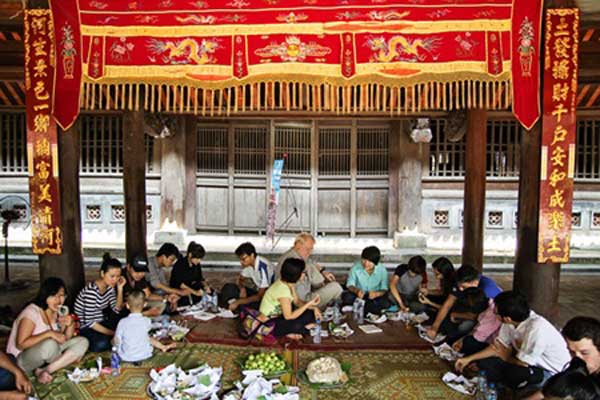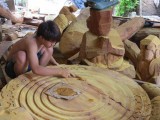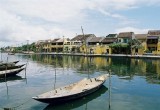Windy Days youth trips explore traditional Vietnamese culture

Wood gazing: Toi Xe Dich members discover the beauty in wooden carving patterns at Tho Ha Village Temple. — Photos toixedich.com
It's a cool autumn morning when senior student Pham Thi Thanh Huyen takes a bus trip with her friends for a one-day tour of the outskirts of Ha Noi.
When the bus reaches the capital's outskirts, they witness a tranquil scene featuring newly harvested rice fields. The fragrance of ripened rice grains seems to linger in the air. In the distance, a blanket of fog covers the remains of withered rice plants on the fields, as well as piles of straw and banana gardens beside ponds.
Yet it's not a normal tour like the ones she had taken before that a professional travel agency had organised. It's a tour guided by Tran Hau Yen The, a lecturer of the Viet Nam National Fine Arts University, and one of the country's most knowledgeable fine arts researchers.
This is also the 11th of the Windy Days trips series organised by Toi Xe Dich (I Move), a non-profit project initiated by a group of Ha Noi-based students to encourage young people to travel more, live more profoundly and gain a deeper understanding of traditional Vietnamese culture.
The Windy Days excursion is organised once a month, gathering mostly students in Ha Noi, as well as experts in folk culture as guides such as researcher Ngo Duc Thinh, cheo (traditional opera) master Tran Dinh Ngon, cheo director Doan Vinh and noted cheo artist Thanh Ngoan.
On this trip, the students explore folk sculpture at Tho Ha Temple in northern Bac Giang Province and Phat Tich Pagoda in nearby Bac Ninh Province.
At their first destination, many of the Windy Days members understand for the first time the beauty of folk sculpture on wooden pillars and decorative panels at Tho Ha Temple, aged more than 300 years.
"In a normal tour organised by professional travel agencies, the guide will not explain and provide much detail on the architecture," Huyen says.
"Today, I discovered lovely couples of stone nghe, an imaginative sacred animal resembling a dog with a long tail that is always placed in holy Vietnamese sites, kissing each other. I also discovered fairies riding dragons, which represent the noble status of women in the old days."
After The's explanation, tour participants chat with an elderly resident who has taken care of the temple for dozens of years to understand more about the temple's history.
"Seeing is believing. The journey offers a really deep experience into traditional arts and culture, though I have to find the best way to explain them effectively," notes The.
At lunch time, the participants enjoy a simple meal prepared by the project initiator.
"A simple dish like com nam, muoi vung, or boiled rice with roasted sesame, peanuts and salt, gio cha or pork saussages, is more tasty when eaten in the shadow of the temple roof amid fresh gusts of wind," says member Tran Ngoc Quynh. "It's an unforgettable experience of the countryside."
At Phat Tich Pagoda, The spends much time talking about holy animals outside the pagoda, their positions and the origin of stone lions.
He explains that one can distinguish between a beautiful statue of Buddha and a normal one depending on the carving lines and the harmony of details on the entire statue.
"That statue is beautiful not only because of a mastery of carving skills but also because of the Buddha's calm face and costume," he adds, pointing at a statue of Buddha inside the pagoda that was cast in 1057 and has been considered as one of Viet Nam's fine arts masterpieces.
"A typical Buddha statue of that time under the Ly dynasty always wears a robe, which is placed with lots of circles around the lower part of the body, symbolising power scattering around the body like what happens when we drop a small stone on a water surface."
That explanation signals the end of the trip. Huyen and many other participants cannot hide the sadness on their faces.
"I made friends with other eager-to-learn students," she says. "We really had fun and learned a lot during the trip. I will surely join next month."
According to Nguyen Thi Thu Ha, the project head, since June 2012, the group has successfully organised 11 Windy Days trips that gathered hundreds of local students, including the ones to explore more-than-100-year-old Long Bien Bridge; cheo art; hau dong, a ritual of spirit mediumship in connection with Dao Mau, a Vietnamese Mother Goddess religion; and the handicraft art of printing Dong Ho paintings.
A graduate of Ha Noi Foreign Trade University, Ha was named runner-up of the 2012 60s Chinh Phuc Nha Dau Tu (60s Investors' Conquest Contest), a playground that Viet Youth Entrepreneurs launched to encourage students to display their knowledge and express their opinions.
Right after the contest, she expanded her Vietnam Travel Radio project, which she submitted to the contest, into toixedich.com, focusing more on promoting the country's culture and art among local youth and tourists.
"Each of the ‘Toi Xe Dich' trips is a reflective journey exploring and looking back on time-honoured traditional values. The trips turn participants' pride into motivation to contribute to the country later on," says Ha, who now works as a marketing agent for a local company.
"‘Move' in our project title is not only moving from space to space but also a move or change in thinking and perception," says Ha.
"The series has gathered students and older people in the city. We hope to gather more foreigners in the city as well as multiply the model in many other localities throughout the country. Join us to see, learn and love," jokes Quynh.
VNS/VNN
 Provincial tourism promotion center strengthens application of digital technology in tourism promotion
Provincial tourism promotion center strengthens application of digital technology in tourism promotion
 Community tourism transforms livelihoods in remote areas
Community tourism transforms livelihoods in remote areas
 Agoda lists Da Lat among cheapest destinations for year-end holidays
Agoda lists Da Lat among cheapest destinations for year-end holidays
 TasteAtlas picks out two Vietnamese dishes among world’s 100 best rated crustacean dishes
TasteAtlas picks out two Vietnamese dishes among world’s 100 best rated crustacean dishes
 Vietravel expands business in Indian market
Vietravel expands business in Indian market
 2025 Nha Trang – Khanh Hoa Sea Festival to spotlight cultural heritage space
2025 Nha Trang – Khanh Hoa Sea Festival to spotlight cultural heritage space
Vietnam, a unique destination attracting Indian tourists: Indian newspaper
 Cao Bang eyes new opportunities for cross-border tourism development
Cao Bang eyes new opportunities for cross-border tourism development
 Kien Giang strives to attract tourists to finish the year on high note
Kien Giang strives to attract tourists to finish the year on high note
 Rivers provide major resources to boost Vietnam’s tourism
Rivers provide major resources to boost Vietnam’s tourism




